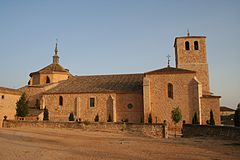Collegiate church
The collegiate church or collegiate church is the Catholic temple that, without being a cathedral, has a chapter. The governing dignity is called dean, although occasionally it is also called abbot or prior.
The choice of a collegiate church is due to different reasons, such as the previous existence of a cathedral in the same city, wanting to give importance to a population without establishing an episcopal seat, for greater splendor of worship, etc. The collegiate can be secular or regular.
This is also the name given to the temple where there is (or was in its time) a community of canons regular of San Agustín presided over by an abbot. The communities of regular canons of San Agustín are at the origin of various religious orders such as the Dominicans or the Premonstratensians.
Currently, a collegiate church is called a collegiate-type main church, with an abbot and canonry, which is not an episcopal seat —cathedral—, and where the divine offices are celebrated with a liturgy similar to that of cathedrals.
Architecture
The collegiate church does not necessarily respond to a specific architectural typology, although, since the Liturgy of the Hours or Divine Office is celebrated in a communal way, they are usually large and have a choir and other elements that they share with the Benedictine or Cistercian monastic churches that also celebrate the Divine Office in community.
Many medieval collegiate churches look similar to the cathedrals of their time, since in the latter there was also a community of canons that celebrated the Divine Office throughout the day. For some people, a collegiate church appeared like a cathedral without a bishop.
Classes of collegiate schools
The class and organization of the collegiate churches have been diverse, due to the causes, purpose and place of their erection. Some participate in the nature and nature of cathedrals: for example, those that, having no bishop, are governed by a prelate with episcopal jurisdiction and with the quality of nullius diocesis.
Its chapters enjoyed, therefore, the same rights as those of the cathedrals, and so much so that they even happen in the jurisdiction of the prelate, whenever his dignity remains vacant.
There are other collegiate churches that do not come close to the nature and nature of cathedrals but in many ways are considered as such, especially if they are governed by a prelate with episcopal jurisdiction, limited to certain limits in the bishop's diocese. It is clear that the chapters of such churches, vacating the prelate's dignity, do not succeed in his rights, as they do to the diocesan bishop; but meanwhile, and being fair, they administer in union with the prelate the rights of the church, according to the tables of the foundation, the custom, the approved statutes or the privileges.
There are also known collegiate churches of monks, which should more properly be called conventual or monastic, but for which it is not appropriate for Even the name of collegiate churches in its strict sense, since they do not have canons and others in which they form the chapter, keeping a method of life very similar to that of the monks and for this reason they are called regulars.
Finally, there are collegiate churches inferior to those we have just enumerated and they are those in which there is a college or chapter of canons but without a prelate with episcopal jurisdiction that is reserved in its entirety and in all its latitude to the diocesan bishop. As for those of this class and the chapters of canons that reside in them, it was customary to erect them after the example and likeness of cathedrals. Thus it is that dignities were created in greater or lesser number and with the same or different denominations in some as in others, the canons and their chapter were granted singular rights and of course they had their statutes, customs and privileges. For this reason, they were and are preferred to simple, non-conventual or non-collegiate churches and even to parochial ones, although they do not have this character.
To the classes of collegiate churches, of which mention has been made, the following can be added:
- the appropriationbecause of the class or importance that in the civil order has the city, village or population where they are founded.
- the parishesAs for their quality of schoolgirls, it is added to serve from its foundation or have been erected after it in parishes.
- of episcopal patronage, Real or particular: those of patronage, according to which they were erected, equipped or restored by the bishops or other ecclesiastical prelates, by the kings or by the great and nobles such as those of San Ildefonso and Berlanga, corresponding to the patrons the presentation of dignity or prebend on them and other royalties or privileges attached to the patronage in accordance with the buds of their erection.
- recepticles, those whose lobby is not composed of a fixed number of canons, but are admitted how many can be killed from the foundation's rents.
Contenido relacionado
Silver burnishing
Camille Pissarro
Protected landscape of the Siete Lomas



